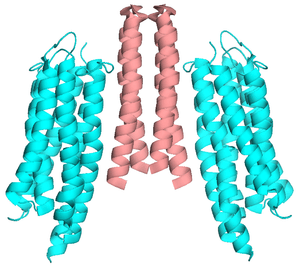Sensory rhodopsin II
Sensory rhodopsin II (SRII), also known as pharaonis phoborhodopsin (ppR), is a membrane protein of archaea, responsible generating the phototaxis signal. Sensory rhodopsin II is found in Halobacterium salinarum and Natronomonas pharaonis.

Structure
Structure of sensory rhodopsin II is typical for microbial rhodopsin. It consists of seven transmembrane a-helices with retinal molecule connected via Schiff base to K205. Notable feature of sensory rhodopsin II is presence of charged residue Y199 on the surface of the hydrophobic region. This residue is responsible for binding of sensory rhodopsin II transducer protein - HtrII. HtrII consists of two transmembrane helices, two HAMP-domains and methyl-accepting signalling domain. In case of Halobacterium salinarum HtrII also comprises extracellular chemosensor region, which is responsible for serine sensing.
Function
SRII in the plasma membrane binds its transducer via a number of bonds. Photon absorption induces structural changes in SRII, which when conducted to HtrII. HtrII in turn regulates level of unbound kinases in cytoplasm. Kinases regulate rotation of flagella via phosphorilation. Thus phototaxis signal is converted in bacteria' motion.
Further reading
- Klare, J.; Chizhov, I.; Engelhard, M. (2008). "Microbial Rhodopsins: Scaffolds for Ion Pumps, Channels, and Sensors". Bioenergetics. Results and Problems in Cell Differentiation. 45. pp. 73–122. doi:10.1007/400_2007_041. ISBN 978-3-540-78621-4. PMID 17898961.
- Sasaki, J.; Spudich, J. (2008). "Signal transfer in haloarchaeal sensory rhodopsin- transducer complexes". Photochemistry and Photobiology. 84 (4): 863–868. doi:10.1111/j.1751-1097.2008.00314.x. PMID 18346091.